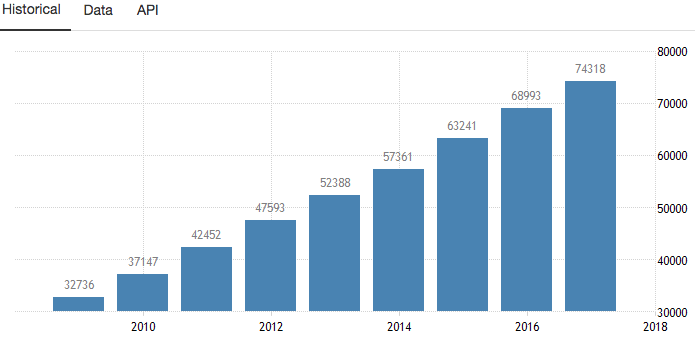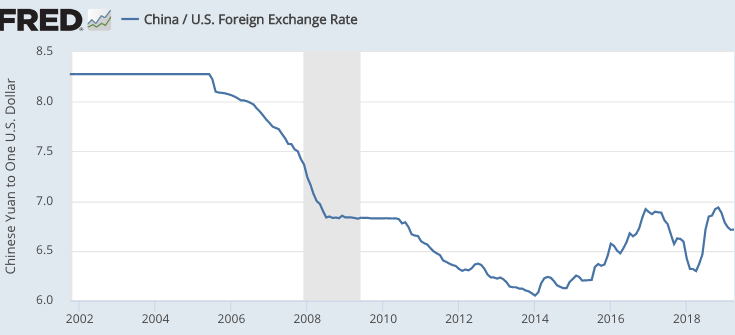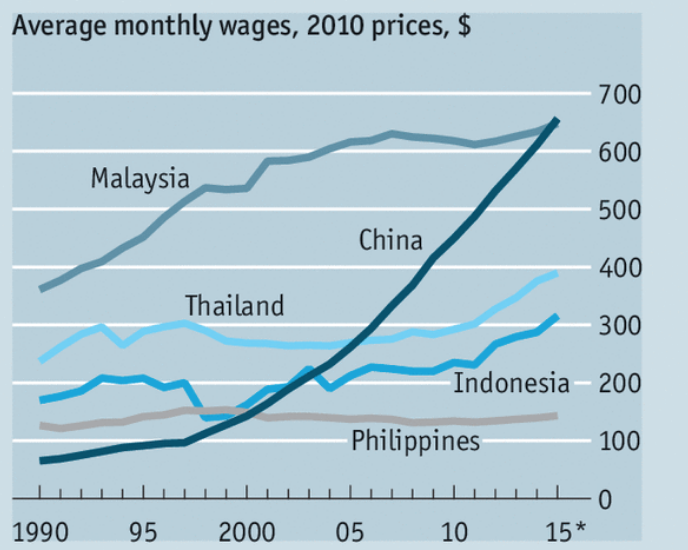Tyler Cowen recently linked to a study of China’s economic growth, which suggests that official figures (roughly 8%) overstate the real GDP growth rate by about 1.8%/year between 2010 and 2016:
Using publicly available data, we provide revised estimates of local and national GDP by re-estimating output of industrial, construction, wholesale and retail firms using data on value-added taxes. We also use several local economic indicators that are less likely to be manipulated by local governments to estimate local and aggregate GDP. The estimates also suggest that the adjustments by the NBS were insufficient after 2008. Relative to the official numbers, we estimate that GDP growth from 2010-2016 is 1.8 percentage points lower and the investment and savings rate in 2016 is 7 percentage points lower.
That might be correct, but I suspect the errors are actually much smaller. Here it’s useful to start with some data that we can have more confidence in, average yearly nominal wage rates (divide by about 6.5 to get the dollar equivalent):
 This matches all sorts of information from a variety of non-governmental sources. When I speak with people who live in China, I get the same impression of very fast rising nominal wages–both for professional jobs and low-skilled jobs like maids. When I read articles in the western media about wages in China, they tell the same story—very fast rising wages leading to many low-skilled firms moving to countries such as Vietnam. It’s much harder to fake nominal wage data than GDP data, because China’s a huge country and local citizens are quite willing to talk about their personal financial situation (unlike during the Maoist era when they would have been terrified to offer truthful information to reporters.) To summarize, we can be almost certain that nominal Chinese wages have grown at explosive rates over the past decade, roughly 10%/year.
This matches all sorts of information from a variety of non-governmental sources. When I speak with people who live in China, I get the same impression of very fast rising nominal wages–both for professional jobs and low-skilled jobs like maids. When I read articles in the western media about wages in China, they tell the same story—very fast rising wages leading to many low-skilled firms moving to countries such as Vietnam. It’s much harder to fake nominal wage data than GDP data, because China’s a huge country and local citizens are quite willing to talk about their personal financial situation (unlike during the Maoist era when they would have been terrified to offer truthful information to reporters.) To summarize, we can be almost certain that nominal Chinese wages have grown at explosive rates over the past decade, roughly 10%/year.
The second piece of evidence is China’s explosive growth in infrastructure, the sort of growth you’d normally see in a fast growing economy like South Korea during the 1970-2010 period, not a Brazil or Mexico. Again, this is easily observed by visitors.
We also see explosive growth in various segments where western firms play a major role, such as auto production. This would be hard to fake. Ditto for China consuming a huge share of the world’s key commodities such as steel, coal, copper, cement, etc.
You might argue that the wage data is nominal and tells us nothing about real wages. That’s true, but we also have very good data on the dollar/yuan exchange rate, which has not changed much since 2009.
 And note that the dollar itself is currently quite strong. If we combine the relatively reliable nominal wage data with the extremely reliable exchange rate data, we see that Chinese wages are also rising at very fast rates in US dollar terms. In addition, Chinese wages have grown much faster that wages in other East Asian countries, economies that are also growing fairly fast.
And note that the dollar itself is currently quite strong. If we combine the relatively reliable nominal wage data with the extremely reliable exchange rate data, we see that Chinese wages are also rising at very fast rates in US dollar terms. In addition, Chinese wages have grown much faster that wages in other East Asian countries, economies that are also growing fairly fast.
 The developing countries in Southeast Asia have recently tended to grow at rates closer to 5%/year, which is roughly the rate that China would have been growing if their official GDP growth rate was overstated by 1.8%/year. But look at Chinese wages compared to those of other Asian economies. Does it seem plausible that China is growing at the same rate as Indonesia?
The developing countries in Southeast Asia have recently tended to grow at rates closer to 5%/year, which is roughly the rate that China would have been growing if their official GDP growth rate was overstated by 1.8%/year. But look at Chinese wages compared to those of other Asian economies. Does it seem plausible that China is growing at the same rate as Indonesia?
If China’s growth rate is consistently overstated, then China should be much poorer than what the official figures show. But if we compare China’s official GDP/person data to places such as Thailand and Malaysia, then the wage data makes it seem like China’s growth has been understated.
Then there is casual empiricism. If China’s growth were overstated, then visitors to China would be telling people, “Hmmm, this doesn’t seem like a country with a per capita GDP of $9600.” But if visitors do offer that opinion, it’s usually because China seems much richer than that figure. At one time one could point to the fact that most Chinese lived in poor villages, but now most live in the cities. At one time one could argue that while the coastal cities were doing well, the interior remained poor. But now interior cities like Chongqing look quite affluent, as evidenced by this excellent NYT story.

I visited Chongqing in 1994, and recall a muddy, drab city full of crumbling grey cement buildings, with lots of poor people carrying heavy loads on their backs.
Again, it’s likely that the Chinese growth numbers are at least somewhat flawed. But when we look at all of the evidence, we cannot have confidence in the claim that Chinese growth has been greatly overstated. There is plenty of evidence in both directions.
PS. In my view, the Chinese boom has been caused by a huge shift of labor into the private sector, where the vast majority of workers are now employed.
PPS. People sometimes cite the fact that a Chinese leader once “admitted” that China’s growth was overstated. That’s not true. He admitted that the provincial growth rates are overstated, a point on which everyone agrees. The national statistical bureau scales back those local estimates before deriving a national growth rate. The issue at hand is whether their downward adjustment is large enough.

READER COMMENTS
Benjamin Cole
Apr 16 2019 at 7:41pm
My two cents is that Scott Sumner is roughly right on China GDP and wages.
The role of the People’s Bank of China in promoting long-term growth is certainly worth a serious investigation and remains a mystery to Westerners. The Sino central bank has long been active in acquiring sour loans and bonds, thus leaving the financial system solvent. The concept of moral hazard is not really a factor in Sino economic planning.
Contrast this Beijing attitude on the repayment of debt to the situation in Greece. The Greek economy contracted by 25% in the Great Recession and has never recovered.
That said, debt levels are rapidly rising in China as they are across the developed world. This troubling aspect of economic growth, that it is a associated with even higher levels of debt, is a problem yet to be resolved.
Phil H
Apr 16 2019 at 8:55pm
I have lived in Xiamen, a southern Chinese city, since 2003, and my anecdotal experience certainly supports what Sumner says. The city has much more than doubled in both size and affluence since I arrived. And when you go outside of the city to smaller towns or villages, you can see a lot more wealth in terms of nice new houses.
The same period has seen the rise of Huawei (I worked for them for a while), a company that competes on equal terms with European and American counterparts, and pays (a significant proportion of) its people as much as or more than its competitors. Low Chinese wages still exist, but there’s a high end now that never existed before.
Jon Murphy
Apr 17 2019 at 7:37am
Question: are the homes occupied? I ask because when I was in China a few years ago (Beijing and Shanghai) there was a ton of construction but I had the distinct impression the buildings were unoccupied/unowned. I’m wondering if my impression was correct.
Phil H
Apr 17 2019 at 10:48am
Hi, Jon. Outside the city, houses are generally built by their occupants. They have a bit of land allotted by the village council, and they can build as large or small a house as they please on it. With the emptying of the villages, sometimes the houses are built big as a bit of a bribe to the younger generation: don’t go to the city, stay here in this 4000 sq ft mansion…
The empty units seen in cities are built by commercial developers. They spotted that land and labor were getting more expensive, and bought their plots early. Because of the heat in the real estate industry, they are generally able to sell all their units and make their money, but the buyers don’t actually want to live there yet, so the units sit empty until the city organically expands around them.
Jon Murphy
Apr 17 2019 at 11:58am
Makes sense. Thanks!
E. Harding
Apr 17 2019 at 1:12am
I think China isn’t growing any faster relative to the West than South Korea or Taiwan when they were at the same level relative to the West as China is today. I think it will stop converging with the US at around 50% of US per capita GDP (PPP) in 30-40 years, and that it’s at around 30% of U.S. GDP per capita (PPP) now. It will be 40% in 2035.
“But if visitors do offer that opinion, it’s usually because China seems much richer than that figure.”
There is enormous urban-rural inequality, and population density also skews perceptions of wealth. There are also limits on the number of poor people who can reside in the big cities.
I agree the Chinese growth numbers are artificially smoothed and overstated by 2 to 3 points per year.
Matthias Görgens
Apr 17 2019 at 4:24am
Apropos Taiwan: why aren’t they richer? They’ve been an Asian tiger for quite a while, and have recently benefitted from close economic ties with the booming PRC.
But they are still at only 25.5k USD of GDP per capita.
Perhaps I am being unfair, because I am comparing to Hong Kong, Singapore and the West. Compared to the rest of the world, Taiwan is rich.
ChrisA
Apr 17 2019 at 5:49am
On Taiwan – I think the reason they don’t have such high measured GDP is that a lot of the economic activity they are involved in is not in Taiwan, it is in China. For instance there are big Taiwanese manufacturing plants in China which are controlled by the head quarters in Taiwan. The profits are recorded in China, so the GDP shows up in China, if it shows up at all in Taiwan it shows as capital gains not as income. As an example this report suggests Taiwan is probably close to Japan in terms of wealth per head, and number 5 in the world. https://taiwantoday.tw/news.php?unit=2,6,10,15,18&post=122472
I think too much is made of income and GDP in terms of cross country comparisons which largely ignores overseas assets holdings and capital gains. If my country has significant increases in house prices for instance, because of it’s reputation perhaps for financial security, this is just as real as any value created by say manufacturing cars. But the GDP and income calculations will ignore the former vs the latter. So in that regard Chinese growth rates are also understated because I would bet there has been very significant increases in capital values of land in the Country over the last 20 years.
Scott Sumner
Apr 17 2019 at 11:56am
Chris, Good point, I would add that PPP estimates for Taiwan are actually higher than Japan, although of course PPP estimates are very imprecise.
E. Harding
Apr 17 2019 at 6:11pm
True, they do tend to be imprecise, but they are surprisingly consistent over time for Taiwan relative to the U.S.
E. Harding
Apr 17 2019 at 10:48am
“But they are still at only 25.5k USD of GDP per capita.”
They’re above Korea/Japan by PPP. The price level is just lower.
Benjamin Cole
Apr 17 2019 at 1:47am
Now here is a non-PC observation:
Sumner’s charts above show China wages soaring, passing all rivals, and even soon to eclipse Malaysia. That is free-market-oriented Malaysia.
Western orthodox economists usually say what Sumner says. China’s stellar gains in wages and GDP is due to a liberalizing economy. But why would China so quickly come to surpass Malaysia, a free-market oriented economy? Shouldn’t Malaysia be pulling away from the still centrally-planned China?
Is the role of central-banking important?
Are other aspects of Beijing’s economic policies—after all, even with a larger private sector, China still operates a dirigiste economy—important for Sino ascendancy?
Or is it the Han Chinese culture?
Matthias Görgens
Apr 17 2019 at 4:28am
Malaysia is actually pretty corrupt. It’s economy and governance is the butt of jokes in Singapore.
There’s not too much of mystery about why Malaysia isn’t richer.
Your other point: Chinese people seem to be able to run economies well, if their government doesn’t obstruct them too much.
In Hong Kong and Singapore obviously there was also some influence of British colonialism. Interestingly, both places seem fairly content with having been British colonies.
Benjamin Cole
Apr 17 2019 at 9:24pm
Matthias: People in Thailand say the same thing, that Siam is corrupt. I have been here six years and I still don’t know anything.
In Hong Kong, people say mainland China financial institutions host corruption the way American biker-rallies host beer. Of course, there is a black hole where there should be a media in mainland China, so who knows anything?
There is a further confounding factor: I do know that in the US there is corruption, and then there is “legal corruption.” A property developer get zoning variance entirely legally, bringing rosy cheeks to financiers able to lend on a nearly fail-safe project. This is the Hong Kong model too, where such legal arrangements have led to the world’s most-expensive housing in relation to incomes (and declining living standards–is a 120-square-foot nano-flat really a higher living standard?). But this arrangement of property deve,opers, financiers and government is not defined as “corrupt.”
The Han Chinese are most successful in Singapore, the apotheosis of a dirigiste economy.
Scott Sumner
Apr 17 2019 at 11:57am
Ben, Check out the average income of the 30% of Malaysians that are ethnic Chinese. It’s far higher than mainland China.
Benjamin Cole
Apr 17 2019 at 9:24pm
The Han Chinese are most successful in Singapore, the apotheosis of a dirigiste economy.
Scott Sumner
Apr 18 2019 at 1:07pm
Every single group that measures economic freedom rates Singapore number 2 in the world. Why should I trust your contrarian view? You cite lots of examples of government interference in Singapore, but there are hundreds of thousands of interventions in capitalist economies like America.
Benjamin Cole
Apr 18 2019 at 8:48pm
You do not have to believe me.
But Singapore-based credentialed economists published in the peer-reviewed Singapore Economic Review themselves define Singapore as a dirigiste economy. Rather matter-of-factly— inside the Singapore cognoscenti I don’t think there is any dispute at all but that Singapore is dirigiste economy.
A dirigiste economy can be and is in the case of Singapore pro-business for those kinds of businesses that want to move to Singapore. Indeed, the city-state offers loads of subsidies and assistance for companies willing to relocate to Singapore. The government of Singapore even built an entire island, Jurong island, to host oil refining businesses in which they own 49% stakes. In short, Singapore will provide land, capital and infrastructure to attract government selected industry.
I presume you are referring to Heritage Foundation studies that rank Singapore No. 1 and Hong Kong No. 2 buy some sort of highly distorted free-enterprise indexes
The Heritage Foundation by now is largely discredited on all fronts. It is a political organization, though in fact I largely agree with many of their theoretical views regarding economies.
But the Heritage Foundation is so political that it lacks any sort of intellectual honesty. They are the sort of intellectuals who scream for tight money when Obama is in office and loose money when Trump is in office, and have all sorts of righteous explanations why they arrive at their conclusions. You place faith in the Heritage Foundation?
By the way, although Singapore is a highly successful dirigiste economy, it is also just a city-state. I am not proposing such a model for a nation -sized nation.
stoneybatter
Apr 17 2019 at 8:38am
To play devil’s advocate: there may be a gap between nominal wage growth and nominal GDP growth. I’m not sure why wages would grow faster in the particular case of China, but it seems like a reasonable possibility. And such a scenario would be consistent with the linked NBER paper (China growth overstated) and some of Sumner’s points (annual wage growth ~10%). Why shouldn’t we apply Occam’s razor here?
Scott Sumner
Apr 17 2019 at 11:59am
I agree that no single point I raised is definitive, but taken together they cast some doubt on the claim that China’s only growing as fast as Indonesia.
eveno
Apr 17 2019 at 11:14am
What things look or feel like aren’t really relevant for GDP numbers. France or Japan don’t “feel” poorer than the US, Switzerland or Norway even if they are significantly so by GDP per capita numbers. If you ever travel in the former USSR or Latin-America there are even better examples of places that are located in “middle income” or worse countries (the Ukraine…) but seem just like anywhere (Kiev) in developed countries with infrastructure, happy shoppers and coffee shops or what else you need to “feel richer than 9600 per capita gdp”… Some smaller countries have wild GDP numbers for reasons that don’t necessarily have all that much effect on the daily lives of the citizens for better or worse. Countries that are favored by multinational business or finance like the Netherlands, Luxemburg and Ireland (25% gdp growth in one year a few years ago…) have higher GDP growth for those reasons. It wouldn’t be surprising if UK and US numbers are also comparatively higher for those reasons. Also China is so big and the GDP in always several times higher in cities compared to rural areas as other mentioned.
Todd Kreider
Apr 18 2019 at 7:59am
Scott wrote: “But if visitors do offer that opinion, it’s usually because China seems much richer than that figure.”
The GDP per capita number they would use is GDP per capta (PPP), which is around $16,000 per year.
” I would add that PPP estimates for Taiwan are actually higher than Japan, although of course PPP estimates are very imprecise.”
No, PPP estimates are not very imprecise.
Scott Sumner
Apr 18 2019 at 1:08pm
Todd, The PPP estimates vary widely from one source to another. So all of them are highly precise? How is that even possible?
Todd Kreider
Apr 18 2019 at 2:45pm
They don’t very wildly as long as you convert to present dollars.
GDP per capita for Japan in 2017 and 2018:
IMF $44,200 (2018)
Wold Bank $43,900 (2017)
OECD $44,400 ($38,100 in $2010) (2017)
I didn’t say “highly precise” – I just said that what you stated, “very imprecise,” was incorrect.
https://en.wikipedia.org/wiki/List_of_countries_by_GDP_(PPP)_per_capita
https://stats.oecd.org/Index.aspx?DataSetCode=PDB_LV
Todd Kreider
Apr 18 2019 at 3:13pm
They don’t very wildly as long as you convert to present dollars.
GDP per capita for Japan in 2017 and 2018:
IMF $44,200 (2018)
Wold Bank $43,900 (2017)
OECD $44,400 ($38,100 in $2010) (2017)
Todd Kreider
Apr 18 2019 at 3:33pm
“vary”
Benjamin Cole
Apr 18 2019 at 10:40pm
Well, if anyone is still reading, this paragraph describes the Singapore economy:
“Much has been written about the pervasive presence of the state in the Singapore economy and the various forms that government intervention in the economy takes.1 The government played a pivotal role not only in mapping out the strategic direction for the economy, but also in driving much of its structural transformation over the past 50 years. Hardly any major strategic or structural change in Singapore in the past five decades took place without the involvement of or a strong push from the government.”
https://ink.library.smu.edu.sg/cgi/viewcontent.cgi?article=2876&context=soe_research
The title of the paper: “The role of the state in Singapore: Pragmatism in
pursuit of growth” By Kim Song TAN Singapore Management University, kstan@smu.edu.sg
Another perspective:
Linda Y.C. Lim, “Singapore’s Success: The Myth of the Free Market Economy”, Asian Survey 26 (1983) 756-764, summarises the role of the state in Singapore’s early economic development.
“From a market perspective, these economies in the 1960s and 1970s developed through free trade by specialising in the export of labour-intensive manufactures based on comparative advantage (relative resource endowments). From a “developmental state” perspective, they relied heavily on stateinterventionist policies which used industrial policy of selective protection and subsidies to direct capital investment to particular sectors, and provided public investment in infrastructure and education to
increase productivity. Industrialisation was further facilitated by conducive macroeconomic policy (including fixed and undervalued exchange rates, and high domestic savings5) and authoritarian political regimes which ensured labour peace and “affordability”, and efficient centralised policy-making with
effective implementation.”
Just for laughs: Singapore imports nearly all it food now, but is implementing a national program to increase domestically produced food to 30% of the toyal, though highly mechanized farm techniques, such as aquaculture, or vegetable grown in stacks indoors hydroponics type stuff.
“Singapore sets 30% goal for home-grown food by 2030”
Technologies such as indoor multi-storey LED lighting for vegetable farms and indoor multi-storey recirculating aquaculture systems. Panasonic’s indoor vegetable farm, which uses an intelligent lighting system, is located in Jalan Ahmad Ibrahim. Technologies such as indoor multi-storey LED lighting for vegetable farms and indoor multi-storey recirculating aquaculture systems can produce 10 to 15 times more than traditional outfits.
Chang Ai-LienScience Editor
Almost one-third of the food that Singapore needs will be home-grown by 2030. This will include vegetables cultivated in climate-controlled greenhouses under special LED lighting to maximise yields, and fish farmed at sea in contained systems to shield them against toxic algae blooms and oil spills.
Ys, free markets at work!
Comments are closed.